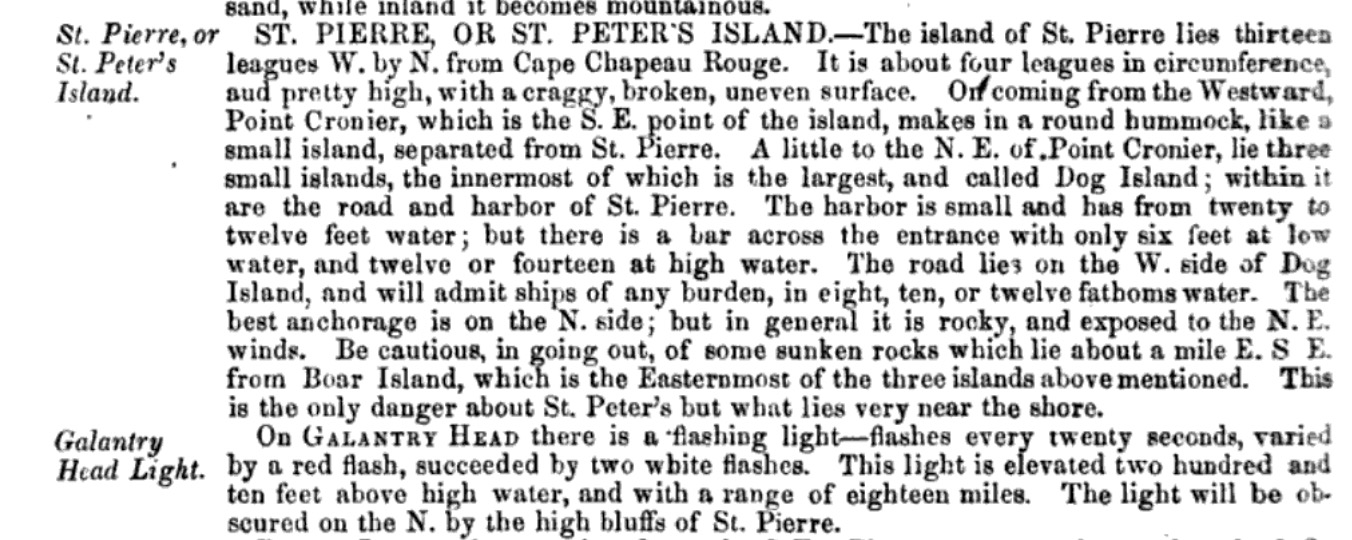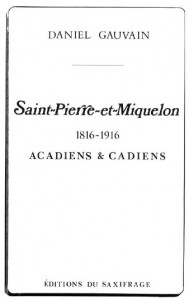The American Coast Pilot: Containing Directions for the Principal Harbors, Capes, and Headlands, on the Coast of North and Part of South America; Describing the Soundings, Bearings of the Light-houses and Beacons from the Rocks, Shoals, Ledges, &c. With the Prevailing Winds, Setting of the Currents, &c. and the Latitudes and Longitudes of the Principal Harbors and Capes; Together with Tide Tables and Variation.
By Edmund M. Blunt.
21st edition by G. W. Blunt, 1867 – 841 pages
New York
Page 40
ST PIERRE OR ST PETER’S ISLAND – The island of St Pierre lies thirteen leagues W by N from Cape Chapeau Rouge. It is about four leagues in circumference of high with a craggy broken uneven surface. On coming from the Westward Point Cronier which is the SE point of the island makes in a round hummock like a small island separated from St Pierre A little to the NE of Point Cronier lie three small islands the innermost of which is the largest and called Dog Island within it are the road and harbor of St Pierre. The harbor is small and has from twenty to twelve feet water but there is a bar across the entrance with only six feet at low water and twelve or fourteen at high water. The road lies on the W side of Dog Island and will admit ships of any burden in eight ten or twelve fathoms water. The best anchorage is on the N side but in general it is rocky and exposed to the NE winds. Be cautious in going out of some sunken rocks which lie about a mile ESE from Boar Island which is the Easternmost of the three islands above mentioned This is the only danger about St Peter’s but what lies very near the shore.
On GALANTRY HEAD there is a flashing light flashes every twenty seconds varied a red flash succeeded by two white flashes. This light is elevated two hundred and ten feet above high water and with a range of eighteen miles. The light will be obscured on the N by the high bluffs of St Pierre.
RANGE LIGHTS for entering from the SE The entrance to the roadstead of St Pierre from the SE is marked by two small fixed lights one of which a white light three fourths of the horizon is situated on the rocks at Canon Point and other a red light on the level N of the city.
The white light is elevated thirty six feet above high water having a range of six and the red light is elevated sixty three feet above high water with a range of miles. The line joining these two lights marks the best water between the extremity of the Bertrand Rocks and Isle Aux Chiens or Dog Island.
The position of the red light is such that any one coming from Columbier and turning into the NE channel upon seeing it to the left of Cape l’Aigle will be in no danger from the shoals off Cape Rouge.
A system of signals during fog has been adopted at St Pierre and Miquelon at the house at the Point de Galantry. For the future from 1st April to 1st November each year there will be fired at the said light house at St Pierre and Miquelon during thick fog two guns every two hours at intervals of three minutes between each six o clock in the morning until six o clock in the evening.
Independently of these regular signals gun for gun will be returned to vessels that be desirous of ascertaining their position by these means.
THE ISLAND OF COLUMBIER lies very near to the NE point of St Pierre It is rather high Between them is a passage one third of a mile wide with twelve fathoms water. On the N side of the island is a rock called Little Columbier and about one fourth of a mile ENE of it is a sunken rock with two fathoms on it.
GREEN ISLAND is about three fourths of a mile in circuit and low It lies EN about five miles from St Pierre and nearly in the middle of the channel between it and Point Mary in Newfoundland On its S side are several rocks above and under extending one mile and one fourth to the WSW
LANGLEY OR LITTLE MIQUELON Langley Island lies to the NW of St Pierre with a passage of about two and a half miles wide between free from danger It is about eight leagues in circuit of a moderate and equal height excepting at the N which is a low point with sand hills off which on both sides it is fiat oil way every other part of the island is bold to There is anchorage on the NE side of island near Seal Cove in five or six fathoms a little to the Southward of the sand on a fine sandy bottom
GREAT MIQUELON From the N point of Langley to the S point of Miquelon distance is scarcely one mile and the depth of water between is two fathoms Mi is four leagues in length from N to S and is about five miles in breadth at the part The middle of the island is high land called the High Lands of Dunne down by the shore it is low excepting Cape Miquelon which is a lofty promontory the Northern extremity of the island
Page 41
On the SE side of the island is the little Harbor of Dunne It is a bar harbor admitting fishing shallops at half flood but no way calculated for shipping
Miquelon Rocks stretch off from the Eastern point of the island under the high land one mile and a fourth to the Eastward Some are above and some under water. The outermost are above water and there are twelve fathoms water close to them with eighteen and twenty a mile off NE4E about four and a half miles from these rocks lies Miquelon Bank on which are six fathoms water
Miquelon Road which is large and spacious lies toward the N end and on the E side of the island between Cape Miquelon and Chapeau which is a very remarkable round mountain near the shore off which are some sunken rocks at the distance of about a quarter of a mile but everywhere else it is clear of danger The best anchorage is in six and seven fathoms near the bottom of the road on fine sandy bottom but there you lie exposed to Easterly winds
The Seal Rocks two in number are above water and lie about one league and a half off from the NW side of Miquelon The passage between them and the island is very o and there are fourteen or fifteen fathoms water within a cable’s length all round them.

